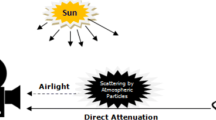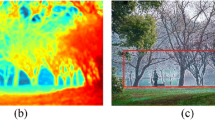Abstract
Effective functioning of outdoor vision systems depends upon the quality of input. Varying effects of light create different weather conditions (like raining, snowfall, haze, mist, fog, and cloud) due to optical properties of light and physical existence of different size particles in the atmosphere. Thus, outdoor images and videos captured in adverse environmental conditions have poor visibility due to scattering of light by atmospheric particles. Visibility restoration (dehazing) of degraded (hazy) images is critical for the useful performance of outdoor vision systems. Most of the existing methods of image dehazing considered atmospheric scattering model (ASM) to improve the visibility of hazy images or videos. According to ASM, the visual quality of dehazed image depends upon accurate estimation of transmission. Existing methods presented different priors with strong assumptions to estimate transmission. The proposed method introduces a tight lower bound on transmission. However, the accuracy of the proposed tight lower bound depends upon minimum color channel of haze-free image. Therefore, a prior is proposed to estimate the minimum color channel of the haze-free image. Furthermore, a blind assessment metric is proposed to evaluate the dehazing methods. Restored and matching corner points of the hazy and haze-free image are used to compute the proposed blind assessment metric. Obtained results are compared with renowned dehazing methods by qualitative and quantitative analysis to prove the efficacy of the proposed method.


















Similar content being viewed by others
References
Lu, H., Li, Y., Nakashima, S., Serikawa, S.: Single image dehazing through improved atmospheric light estimation. Multimed. Tools Appl. 75(24), 17081–17096 (2016)
Raikwar, S.C., Tapaswi, S.: An improved linear depth model for single image fog removal. Multimed. Tools Appl. 77(15), 19719–19744 (2018). https://doi.org/10.1007/s11042-017-5398-y
Huimin, L., Li, Y., Chen, M., Kim, H., Serikawa, S.: Brain intelligence: go beyond artificial intelligence. Mob. Netw. Appl. 23(2), 368–375 (2018)
Narasimhan, Srinivasa G.: Models and Algorithms for Vision Through the Atmosphere. PhD thesis, New York, NY, USA (2004). AAI3115363
He, K., Sun, J., Tang, X.: Single image haze removal using dark channel prior. IEEE Trans. Pattern Anal. Mach. Intell. 33(12), 2341–2353 (2011)
Zhang, Y.-Q., Ding, Y., Xiao, J.-S., Liu, J., Guo, Z.: Visibility enhancement using an image filtering approach. EURASIP J. Adv. Signal Process. 2012(1), 220–225 (2012)
Ling, Z., Fan, G., Gong, J., Wang, Y., Xiao, L.: Perception oriented transmission estimation for high quality image dehazing. Neurocomputing 224, 82–95 (2017)
Kim, T.K., Paik, J.K., Kang, B.S.: Contrast enhancement system using spatially adaptive histogram equalization with temporal fltering. IEEE Trans. Consum. Electron. 44(1), 82–87 (1998)
Alex Stark, J.: Adaptive image contrast enhancement using generalizations of histogram equalization. IEEE Trans. Image Process. 9(5), 889–896 (2000)
Kim, J.-Y., Kim, L.-S., Hwang, S.-H.: An advanced contrast enhancement using partially overlapped sub-block histogram equalization. IEEE Trans. Circuits Syst. Video Technol. 11(4), 475–484 (2001)
Li, Y., Huimin, L., Li, J., Li, X., Li, Y., Serikawa, S.: Underwater image de-scattering and classification by deep neural network. Comput. Electr. Eng. 54(C), 68–77 (2016)
Tan, K., Oakley, J.P.: Enhancement of color images in poor visibility conditions. In: Proceedings of IEEE Conference on Image Processing, vol. 2, pp. 788–791 (September 2000)
Nayar, S.K., Narasimhan, S.G.: Interactive deweathering of an image using physical models. In: Proceedings of IEEE Workshop on Color and Photometric Methods in Computer Vision in cnjunction with IEEE Conference on Computer Vision (October 2003)
Nayar, S.K., Narasimhan, S.G.: Vision in bad weather. In: Proceedings of IEEE Conference on Computer Vision, vol. 2, 820–827 (September 1999)
Schechner, Y.Y., Narasimhan, S.G., Nayar, S.K.: Instant dehazing of images using polarization. In: Proceedings of IEEE Conference on Computer Vision and Pattern Recognition, vol. 1, pp. 325–332 (February 2001)
Narasimhan, S.G., Nayar, S.K.: Contrast restoration of weather degraded images. IEEE Trans. Pattern Anal. Mach. Intell. 25(6), 713–724 (2003)
Narasimhan, S.G., Nayar, S.K.: Chromatic framework for vision in bad weather. In: Proceedings of IEEE Conference on Computer Vision and Pattern Recognition, vol. 1, pp. 598–605 (June 2000)
Shwartz, S., Namer, E., Schechner, Y.Y.: Blind haze separation. In: Proceedings of IEEE Conference on Computer Vision and Pattern Recognition, vol. 2, pp. 1984–1991 (February 2006)
He, K., Sun, J., Tang, X.: Guided image filtering. IEEE Trans. Pattern Anal. Mach. Intell. 35(6), 1397–1409 (2012)
Meng, G., Wang, Y., Duan, J., Xiang, S., Pan, C.: Efficient image dehazing with boundary constraint and contextual regularization. In: Proceedings of IEEE International Conference on Computer Vision, pp. 617 – 624 (2013)
Tan, R.: Visibility in bad weather from a single image. In: Proceedings of IEEE Conference on Computer Vision and Pattern Recognition, pp. 24–26 (June 2008)
Tarel, J.P., Hautière, N.: Fast visibility restoration from a single color or gray level image. In: Proceedings of IEEE International Conference on Computer Vision, pp. 2201–2208 (September 2009)
Xiao, C., Gan, J.: Fast image dehazing using guided joint bilateral filter. Vis. Comput. Int. J. Comput. Graph. 28(6–8), 713–721 (2012)
Jha, D.K., Gupta, B., Lamba, S.S.: l2-norm-based prior for haze-removal from single image. IET Comput. Vis. 10(5), 331–341 (2016)
Kim, J.-H., Jang, W.-D., Sim, J.-Y., Kim, C.-S.: Optimized contrast enhancement for real-time image and video dehazing. J. Vis. Commun. Image Represent. 24(3), 410–425 (2013)
Liu, S., Rahman, M.A., Liu, S.C., Wong, C.Y., Lin, C.-F., Wu, H., Kwok, N.: Image de-hazing from the perspective of noise filtering. Comput. Electr. Eng. 62(August 2017), 345–359 (2016)
Berman, D., Treibitz, T., Avidan, S.: Non-local image dehazing. In: IEEE Conference on Computer Vision and Pattern Recognition (CVPR) (2016)
Wang, W., Yuan, X., Xiaojin, W., Liu, Y.: Dehazing for images with large sky region. Neurocomputing 238(Supplement C), 365–376 (2017)
Tang, K., Yang, J., Wang, J.: Investigating haze-relevant features in a learning framework for image dehazing. In: Proceedings of IEEE International Conference on Computer Vision and Pattern Recognition, pp. 2995–3002 (2014)
Zhu, Q., Mai, J., Shao, L.: A fast single image haze removal algorithm using color attenuation prior. IEEE TRans. Image Process. 24(11), 3522–3533 (2015)
Wang, W., Yuan, X., Xiaojin, W., Liu, Y.: Fast image dehazing method based on linear transformation. IEEE Trans. Multimed. 19(6), 1142–1155 (2017)
Li, Y., Miao, Q., Song, J., Quan, Y., Li, W.: Single image haze removal based on haze physical characteristics and adaptive sky region detection. Neurocomputing 182, 221–234 (2016)
Yuan, H., Liu, C., Guo, Z., Sun, Z.: A region-wised medium transmission based image dehazing method. IEEE Access 5, 1735–1742 (2017)
Silberman, N., Kohli, P., Hoiem, D., Fergus, R.: Indoor segmentation and support inference from rgbd images. In: ECCV (2012)
Hautiére, N., Tarel, J.-P., Lavenant, J., Aubert, D.: Automatic fog detection and estimation of visibility distance through use of an onboard camera. Mach. Vis. Appl. 17(1), 8–20 (2006)
Choi, K.Y., Jeong, K.M., Song, B.C.: Fog detection for de-fogging of road driving images. In: 2017 IEEE 20th International Conference on Intelligent Transportation Systems (ITSC), pp. 1–6 (Oct 2017)
Ma, K., Liu, W., Wang, Z.: Perceptual evaluation of single image dehazing algorithms. In: Proceedings of IEEE International Conference on Image Processing (September 2015)
Tarel, J.-P., Hautière, N., Cord, A., Gruyer, D., Halmaoui, H.: Improved visibility of road scene images under heterogeneous fog. In: Proceedings of IEEE Intelligent Vehicle Symposium(IV’2010), San Diego, California, USA, pp. 478–485 (2010). http://perso.lcpc.frtarel.jean-philippe/publis/iv10.html
Bui, T.M., Kim, W.: Single image dehazing using color ellipsoid prior. IEEE Trans. Image Process. 27(2), 999–1009 (2018)
Khmag, A., Al-Haddad, S.A.R., Ramli, A.R., Kalantar, B.: Single image dehazing using second-generation wavelet transforms and the mean vector l2-norm. Vis. Comput. 34(5), 675–688 (2018)
Yong, X., Wen, J., Fei, L., Zhang, Z.: Review of video and image defogging algorithms and related studies on image restoration and enhancement. IEEE Access 4, 165–188 (2015)
Wang, R., Li, R., sun, H.: Haze removal based on multiple scattering model with superpixel algorithm. J. Signal Process. 127(C), 24–36 (2016)
Lu, H., Li, Y., Xu, X., He, L., Li, Y., Dansereau, D., Serikawa, S.: Underwater image descattering and quality assessment. In: 2016 IEEE International Conference on Image Processing (ICIP), pp. 1998–2002 (Sept 2016)
Wang, Z., Bovik, A.C., Sheikh, H.R., Simoncelli, E.P.: Image qualifty assessment: from error visibility to structural similarity. IEEE Trans. Image Process. 13(4), 600–612 (2004)
Wang, Z.: The SSIM index for image quality assessment (2003). https://ece.uwaterloo.ca/~z70wang/research/ssim/. Accessed 9 Nov 2014
Huimin, L., Li, Y., Zhang, L., Serikawa, S.: Contrast enhancement for images in turbid water. J. Opt. Soc. Am. A 32(5), 886–893 (2015)
Serikawa, S., Huimin, L.: Underwater image dehazing using joint trilateral filter. Comput. Electr. Eng. 40(1), 41–50 (2014). 40th-year commemorative issue
Ling, Z., Li, S., Wang, Y., Shen, H., Xiao, L.: Adaptive transmission compensation via human visual system for efficient single image dehazing. Vis. Comput. 32(5), 653–662 (2016)
Mantiuk, R., Kim, K.J., Rempel, A.G., Heidrich, W.: Hdr-vdp-2: a calibrated visual metric for visibility and quality predictions in all luminance conditions. ACM Trans. Graph. 30(4), 40:1–40:14 (2011)
Mantiuk, R., Kim, K.J., Rempel, A.G., Heidrich, W.: Hdr-vdp-2: A calibrated visual metric for visibility and quality predictions in all luminance conditions. In: ACM SIGGRAPH 2011 Papers, SIGGRAPH’11, New York, NY, USA. ACM, pp. 40:1–40:14 (2011)
Dawn, D.D.Â., Shaikh, S.H.: A comprehensive survey of human action recognition with sspatio-temporal interest point (stip) detector. Vis. Comput. 32(3), 289–306 (2016)
Li, Y., Lu, H., Li, K.-C., Kim, Y., Serikawa, S.: Non-uniform de-scattering and de-blurring of underwater images. Mobile Netw. Appl. 23(2), 352–362 (2018)
Author information
Authors and Affiliations
Corresponding author
Ethics declarations
Conflict of interest
Authors Suresh Chandra Raikwar and Shashikala Tapaswi declare that they do not have any conflict of interest.
Rights and permissions
About this article
Cite this article
Raikwar, S.C., Tapaswi, S. Tight lower bound on transmission for single image dehazing. Vis Comput 36, 191–209 (2020). https://doi.org/10.1007/s00371-018-1596-5
Published:
Issue Date:
DOI: https://doi.org/10.1007/s00371-018-1596-5




